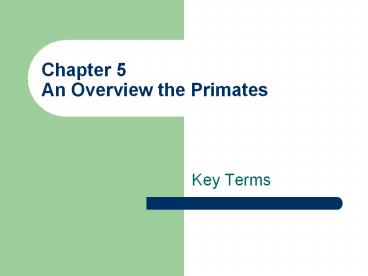Chapter%205%20An%20Overview%20the%20Primates - PowerPoint PPT Presentation
Title:
Chapter%205%20An%20Overview%20the%20Primates
Description:
primatologists Scientists who study the evolution, anatomy, ... arm swinging. hominoids Members of the superfamily Hominoidea includes apes (chimpanzees, ... – PowerPoint PPT presentation
Number of Views:146
Avg rating:3.0/5.0
Title: Chapter%205%20An%20Overview%20the%20Primates
1
Chapter 5An Overview the Primates
- Key Terms
2
- prosimiansMembers of a suborder of primates
(lemurs, lorises and tarsiers). - anthropoidsMembers of a suborder of primates
(monkeys, apes and humans).
3
- primitiveReferring to a trait or a combination
of traits present in an ancestral form. - specializedEvolved for a particular function
usually refers to a specific trait.
4
- primatologistsScientists who study the
evolution, anatomy, and behavior of nonhuman
primates. - morphologyThe form of anatomical structures can
also refer to the entire organism.
5
- omnivorousHaving a diet consisting of many food
times (plants, meat and insects). - nocturnalActive at night.
6
- diurnalActive during the day.
- stereoscopic visionVisual images are, to varying
degrees, superimposed on one another. Provides
for depth perception or the perception of three
dimensions.
7
- binocular visionVision characterized by
overlapping visual fields provided by forward
facing eyes. - arborealtree living
8
- arboreal hypothesisView that primate
characteristics can be explained as a consequence
of primate diversification in arboreal habitats.
- visual predation hypothesisPrimates may have
first adapted to shrubby forest undergrowth and
the lowest tiers of the forest canopy, where they
captured insects and other small prey primarily
through stealth.
9
- adaptive nicheThe entire way of life of one
organism where it lives, what it eats, how it
gets food, how it avoids predators, etc. - intelligenceThe ability to learn, reason, or
comprehend and interpret information, facts,
relationships, meanings, etc.
10
- arboreal hypothesisThe traditional view that
primate characteristics can be explained as a
consequence of primate diversification into
arboreal habitats. - cuspsThe elevated portions on the chewing
surfaces of premolar and molar teeth.
11
- quadrupedalUsing all four limbs to support the
bodyduring locomotion. - brachiationA form of locomotion in which the
body is suspended beneath the hands and support
is alternated from one limb to the other arm
swinging.
12
- hominoidsMembers of the superfamily Hominoidea
includes apes (chimpanzees, bonobos, gorillas,
orangutans, gibbons, and siamangs) and humans. - sexual dimorphismDifferences in physical
characteristics between males and females of the
same species.
13
- estrusPeriod of sexual receptivity in female
mammals correlated with ovulation. - homoplasyThe separate evolutionary development
of similar characteristics in different groups of
organisms.
14
- hominoidsThe formal description for the
superfamily of anthropoids that includes apes
and humans. - frugivorousHaving a diet composed primarily of
fruit.































